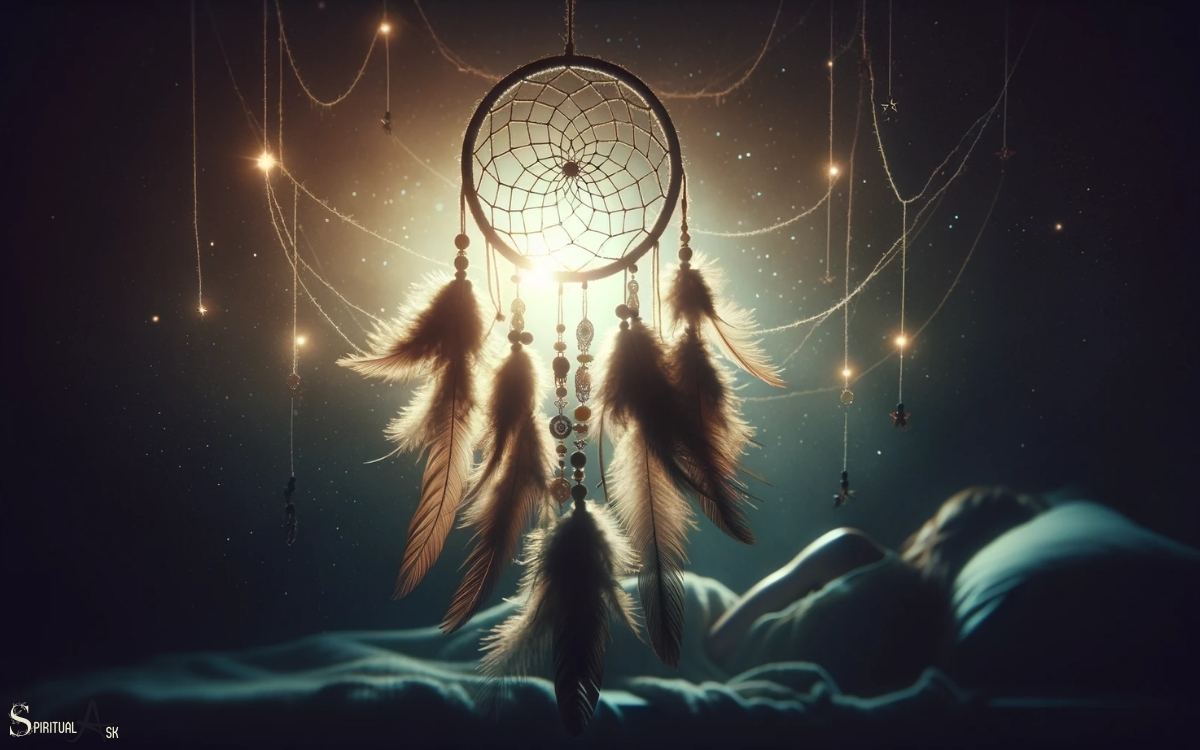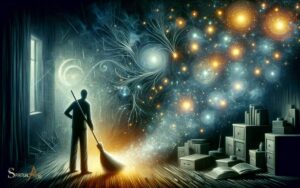Spiritual Meaning of Dream Catchers: Negative Thoughts!
The spiritual meaning of dream catchers is to protect individuals from negative dreams and thoughts, while allowing positive dreams to pass through.
Originating from Native American cultures, dream catchers are handmade objects traditionally made from a wooden hoop with a woven web, adorned with feathers and beads.
They are hung above the bed or sleeping area to act as spiritual guardians during sleep. The webbing is believed to catch nightmares and negative thoughts, which are then destroyed by the morning light.
On the other hand, the positive dreams and thoughts are allowed to flow down the feathers and into the sleeper’s mind.
In modern times, dream catchers have become popular decorative items and spiritual tools for people from various cultures, transcending their original tribal roots.
They are often used as symbols of connection to Native American heritage and spirituality, as well as tools for promoting a good night’s sleep and mental well-being.
Furthermore, dream catchers come in various shapes, sizes, and designs, making them not only spiritually significant but also visually appealing.

Key Takeaway
8 Aspects: Spiritual Meaning of Dream Catchers
| Aspect | Spiritual Meaning |
|---|---|
| Dream Catcher Origin | Based on Native American tradition, specifically the Ojibwe people, to protect individuals from bad dreams and nightmares. |
| Web Design | Represents the spider’s web, symbolizing the cycle of life and the intricate connection between all living things. |
| Center of the Web | Believed to symbolize the Great Spirit or Creator, who is the source of all spiritual energy and protection. |
| Feathers | Represents air, breath, and life, allowing good dreams to gently float down into the dreamer’s mind. |
| Beads | Symbolizes the spider, the dream catcher’s weaver, and represents spiritual connections among different aspects of life. |
| Hoop Shape | The circular shape represents the circle of life and the continuous flow of time, a reminder of life’s natural cycles. |
| Colors | Each color has a different spiritual meaning, such as blue for protection, red for courage, and white for purity. |
| Personalization | Adding personal items to the dream catcher enhances its spiritual power and provides a connection to the dreamer’s spirit. |
History of Dream Catchers
The history of dream catchers dates back to the Ojibwe people, who are credited with creating these intricate handmade objects. The Ojibwe, also known as the Chippewa, are an indigenous group from the Great Lakes region of North America.
Traditionally, dream catchers were constructed using willow branches formed into a small hoop, with a woven net or web inside and adorned with meaningful items such as feathers and beads.
The purpose of the dream catcher was to filter out bad dreams and only allow good dreams to pass through and enter the mind of the sleeper. This concept was deeply rooted in Ojibwe spiritual beliefs.
Over time, dream catchers have become popular symbols beyond Ojibwe culture, often associated with protection and positivity.
Symbolism in Native American Culture
The symbolism of dream catchers in Native American culture is deeply rooted in their history and spiritual beliefs.
Understanding the origins and cultural significance of dream catchers can provide valuable insight into the traditions and values of Native American communities.
Exploring the symbolism of dream catchers offers an opportunity to appreciate the richness and complexity of Native American culture.
Dream Catcher Origins
Dream catchers have been a significant symbol in Native American culture for centuries, representing the spiritual beliefs and traditions of various tribes.
The origins of dream catchers can be traced back to the Ojibwe (Chippewa) people, who created them as a way to protect individuals, especially children, from bad dreams and negative energies.
The circular shape of the dream catcher represents the circle of life and the journey of the sun and moon across the sky.
Traditionally, dream catchers were made using willow hoops and sinew, and adorned with sacred items such as feathers and beads.
Each element of the dream catcher holds symbolism, reflecting the interconnectedness of life and the spiritual beliefs of the Native American people.
Understanding the origins of dream catchers provides insight into their cultural significance.
Cultural Significance Explained
Rooted in the spiritual beliefs and traditions of various Native American tribes, the cultural significance of dream catchers is deeply intertwined with the symbolism of their sacred elements.
| Symbol | Meaning |
|---|---|
| Circle | Represents the circle of life and the sun, with no beginning or end, symbolizing the continuous flow of life and the seasons. |
| Feathers | Symbolize breath, air, and the path to the dream world. They are thought to help the good dreams reach the dreamer. |
| Beads | Reflect the interconnectedness of all living things and the web of life that supports and connects all beings. |
| Web | Represents the interconnectedness of the universe and the journey of life, with the center hole allowing good dreams to pass through. |
Understanding the symbolism in Native American culture provides a glimpse into the profound meaning and significance behind the creation and display of dream catchers.
Construction and Design
The construction and design of dream catchers hold significant symbolism in Native American culture.
The weaving patterns symbolize the interconnectedness of life, while the feathers incorporated into the design carry cultural significance, often representing aspects of nature and spirituality.
Additionally, the circular shape of the dream catcher serves a specific purpose in filtering out negative energy and allowing positive dreams to flow through.
Symbolism in Weaving
An integral aspect of the spiritual and cultural significance of dream catchers lies in the symbolism inherent in their weaving, construction, and design.
The symbolism in the weaving of dream catchers includes:
- The Circular Shape: The circular frame represents the circle of life and the journey of the sun and moon across the sky.
- The Center Hole: Symbolizes the passage of good dreams, allowing them to filter through and reach the dreamer while trapping the bad dreams.
- The Web: Represents the interconnectedness of all living beings and the web of life that weaves through time and space.
- The Feathers and Beads: Each feather and bead attached to the dream catcher holds its own symbolism, often representing aspects of nature, spirituality, and personal journey.
Cultural Significance of Feathers
Feathers are intricately incorporated into the construction and design of dream catchers, often symbolizing spiritual significance and cultural heritage.
In many Native American cultures, feathers are believed to represent the connection between the dreamer and the spiritual world.
The choice of feathers used in a dream catcher can hold specific meanings; for example, eagle feathers are highly revered for their association with courage and strength, while owl feathers are associated with wisdom and insight.
The process of attaching the feathers to the dream catcher is also significant, often following specific traditional methods that have been passed down through generations.
The use of feathers in dream catchers not only adds to their aesthetic appeal but also carries deep cultural and spiritual significance, making them a cherished symbol in many indigenous communities.
This cultural significance extends beyond mere decoration, serving to enhance the spiritual power of the dream catcher.
Purpose of Circular Shape
Incorporating the cultural significance of feathers, the purpose of the circular shape in the construction and design of dream catchers holds profound spiritual and symbolic importance.
The circular shape represents the interconnectedness of all living beings and the eternal flow of energy and life.
The construction of the circular frame using natural materials symbolizes the harmony between humans and nature.
Additionally, the circular shape is believed to act as a protective barrier, trapping negative energy and preventing it from entering the dreams of the sleeper.
The symmetry of the circle is also thought to bring balance and harmony to the dreamer’s life, promoting a sense of peace and well-being.
The circular design of dream catchers is deeply rooted in spiritual traditions and is believed to hold great significance in promoting positive energy and protection.
This leads us to explore the spiritual significance of dream catchers and their role in guiding and protecting individuals’ spiritual journeys.
Spiritual Significance
The spiritual significance of dream catchers lies in their role as symbols of protection and filtering out negative energy. These handcrafted artifacts are traditionally believed to ensnare bad dreams, allowing only good ones to pass through to the sleeper. This practice reflects a deeper understanding of the spiritual meaning of dreams, suggesting that our subconscious messages must be nurtured and protected. By incorporating dream catchers into one’s personal space, individuals seek to create a harmonious environment that fosters positive thoughts and promotes spiritual well-being.
Originating from Native American cultures, dream catchers are believed to capture bad dreams and negative thoughts, allowing only good dreams to pass through and slide down the feathers to the sleeper.
This spiritual significance is rooted in the idea that the web-like design represents the interconnectedness of all living beings and the universe. Therefore, dream catchers are seen as promoting harmony and balance, while warding off negativity.
Additionally, the beads and feathers attached to the dream catcher are thought to symbolize the elements of Earth and the breath of life, enhancing its spiritual significance as a tool for promoting positive energy and well-being.
Dream Catchers in Modern Context
In modern context, dream catchers continue to be regarded as symbols of protection and are widely used in various spiritual and wellness practices. They have transcended their original cultural significance and have become popular decorative items as well.
Here are four ways in which dream catchers are utilized in modern society:
- Decorative Purposes: Dream catchers are often used as decorative elements in homes, offices, and wellness spaces to create a calming and peaceful atmosphere.
- Spiritual Practices: Many individuals use dream catchers as part of their spiritual rituals, ceremonies, and meditation practices to promote positive energy flow and protection from negative influences.
- Healing Therapies: Some wellness practitioners incorporate dream catchers into their healing therapies, such as reiki and crystal healing, to aid in the removal of negative energy and promote holistic well-being.
- Cultural Appreciation: In modern society, dream catchers are also used as a way to appreciate and honor Native American culture and traditions, raising awareness about their significance and history.
Impact on Dreaming and Spiritual Connection
Utilizing dream catchers in spiritual practices and healing therapies has a profound impact on individuals’ dreaming experiences and their spiritual connection.
Dream catchers are believed to filter out negative dreams and promote positive ones, leading to a more peaceful and undisturbed sleep. This, in turn, can enhance the overall quality of dreaming experiences, making them more vivid and insightful.
Furthermore, in many spiritual traditions, dream catchers are seen as a tool for connecting with the spiritual realm and accessing higher levels of consciousness during sleep.
By hanging a dream catcher near the bed, individuals aim to establish a protective and spiritually conducive environment, which can facilitate a deeper connection with their inner selves and the spiritual world.
As a result, dream catchers are valued for their potential to enhance both the dreaming experience and spiritual connection.
Cultural Appropriation and Respect
Dream catchers have been misappropriated and commodified, raising concerns about cultural respect and authenticity. The appropriation of dream catchers has led to a dilution of their spiritual and cultural significance.
It’s important to approach the topic of dream catchers with sensitivity and respect for the Native American cultures from which they originate.
To address these concerns, it is essential to understand and acknowledge the cultural and spiritual significance of dream catchers.
Here are four key considerations for cultural appropriation and respect:
- Historical Context: Understanding the origins and traditional use of dream catchers in Native American cultures is crucial.
- Respectful Representation: Ensuring that the production and display of dream catchers are respectful and accurately represent their cultural significance.
- Consultation and Collaboration: Engaging with Native American communities and individuals to gain insight and permission for the use of dream catcher imagery.
- Educational Outreach: Providing educational resources to raise awareness about the cultural and spiritual significance of dream catchers and the impact of misappropriation.
Conclusion
The spiritual significance of dream catchers is deeply rooted in Native American culture and beliefs.
The history, construction, and symbolism of dream catchers hold great importance in understanding their spiritual meaning.
While dream catchers have become popular in modern culture, it is important to respect their origins and cultural significance.
Just as a dream catcher filters out negative dreams, it is important to filter out cultural appropriation and show respect for the traditions from which they are derived.






